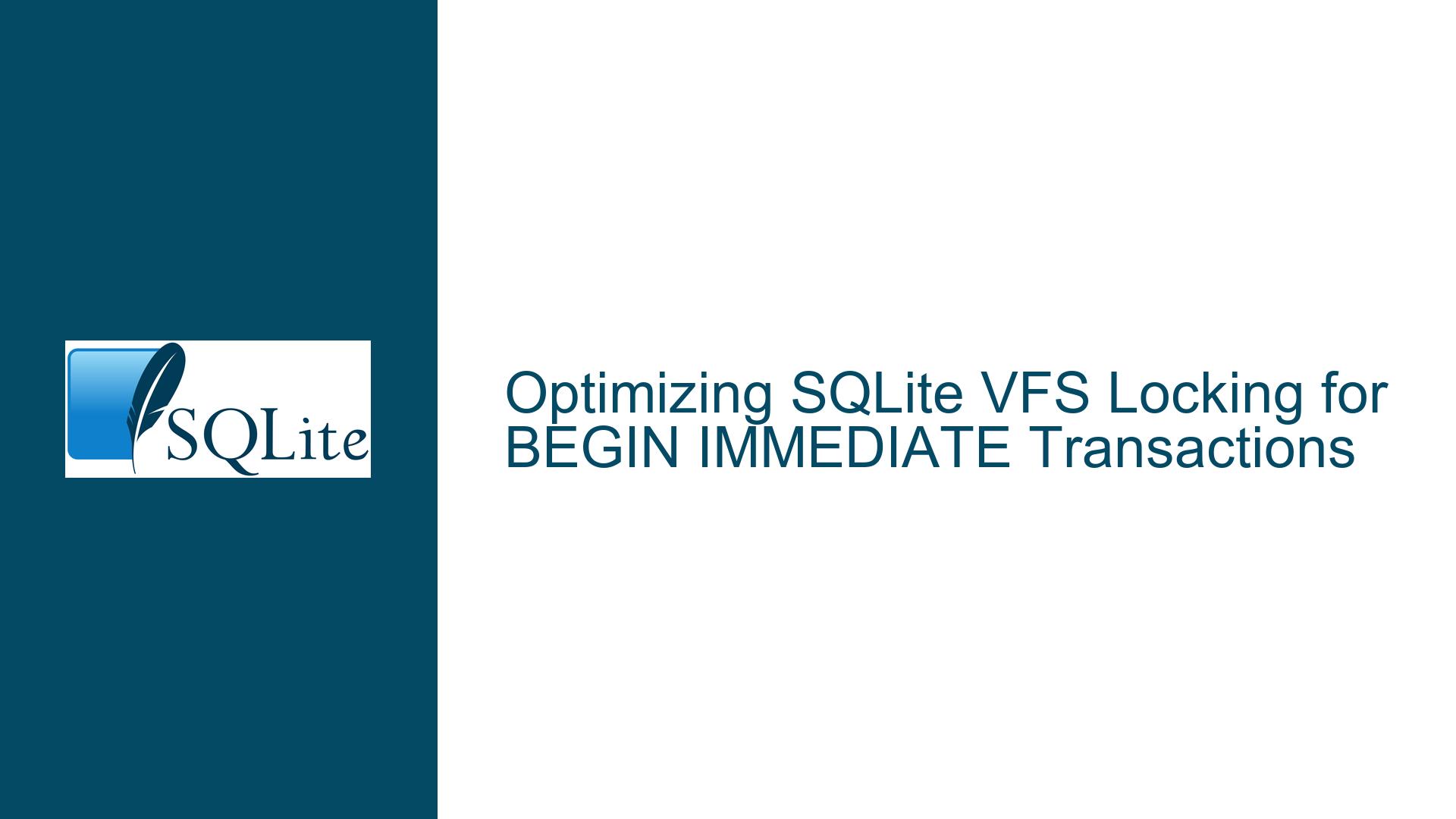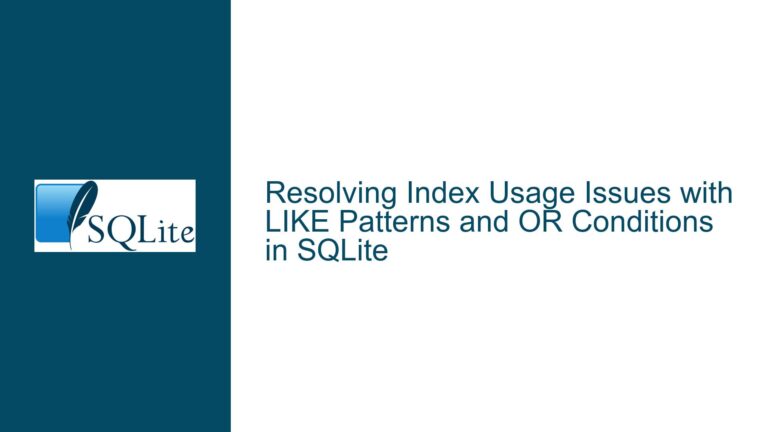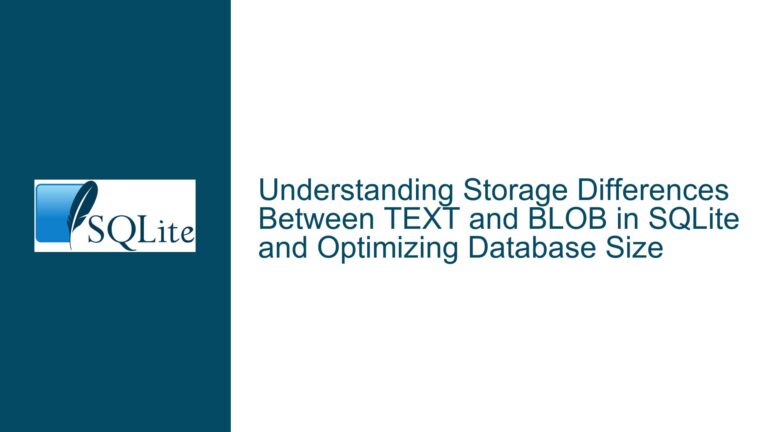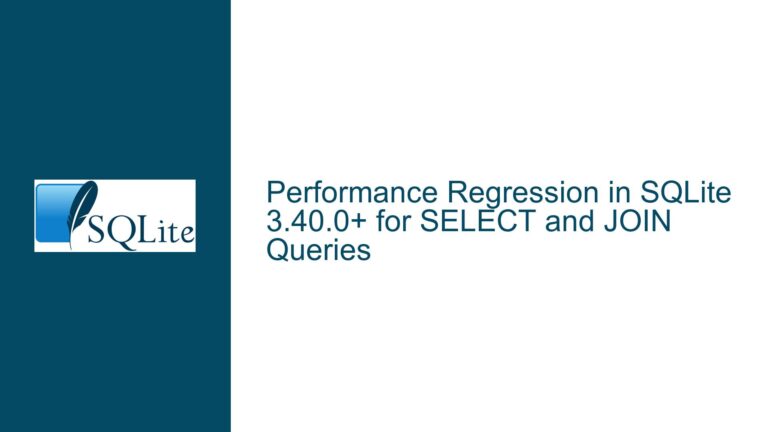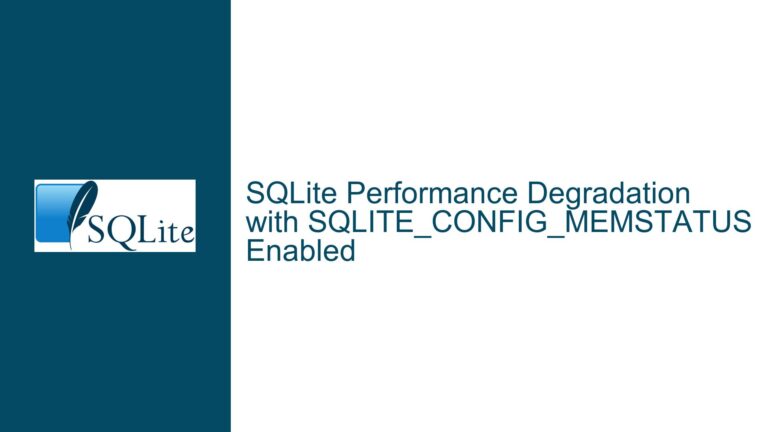Optimizing SQLite VFS Locking for BEGIN IMMEDIATE Transactions
Understanding the VFS Locking Sequence in BEGIN IMMEDIATE Transactions
When a SQLite database initiates a BEGIN IMMEDIATE transaction, the Virtual File System (VFS) layer performs a sequence of operations to ensure data integrity and concurrency control. The sequence typically involves acquiring a SHARED lock, checking for the existence of a hot journal, reading a portion of the database file, and then attempting to upgrade to a RESERVED lock. This sequence is critical for maintaining the atomicity and durability of transactions, especially in environments where multiple processes or threads may access the database concurrently.
The standard locking sequence for a BEGIN IMMEDIATE transaction without Write-Ahead Logging (WAL) mode is as follows:
- Acquire a
SHAREDlock on the database file. - Check for the presence of a hot journal file.
- Read a specific portion of the database file (typically 16 bytes at offset 24).
- Check for the presence of a WAL file (even though WAL mode is not enabled).
- Determine the size of the database file.
- Attempt to upgrade the
SHAREDlock to aRESERVEDlock.
This sequence ensures that no other process can write to the database while the transaction is in progress. However, the ordering of these operations has implications for performance, particularly in high-concurrency scenarios. For example, if the RESERVED lock request fails (e.g., due to another process holding a conflicting lock), the database must retry the operation, potentially wasting resources and increasing latency.
The core issue revolves around whether the locking sequence can be optimized to reduce unnecessary operations, particularly when the RESERVED lock request is likely to fail. Specifically, the question is whether the RESERVED lock can be attempted earlier in the sequence, before performing reads or journal checks, to minimize resource consumption and improve fairness in lock acquisition.
Potential Downsides of Reordering VFS Locking Operations
Reordering the VFS locking sequence to prioritize the RESERVED lock request introduces several technical challenges and potential downsides. The primary concern is the handling of hot journals, which are journal files left behind by a failed transaction. A hot journal indicates that the database may be in an inconsistent state, and any process accessing the database must first recover from the journal to ensure data integrity.
If the RESERVED lock is acquired before checking for a hot journal, a race condition could arise. Specifically, another process might mistakenly conclude that the journal is not hot (because the RESERVED lock is held) and proceed to read the database file, potentially accessing corrupted data. This scenario violates SQLite’s atomic commit protocol and compromises the database’s reliability.
Another consideration is the interaction between the SHARED and RESERVED locks. The SHARED lock allows multiple readers to access the database concurrently, while the RESERVED lock signals an intent to write. If the RESERVED lock is acquired too early, it may unnecessarily block other readers, reducing concurrency and overall system throughput. This is particularly problematic for workloads with a high ratio of reads to writes.
Furthermore, reordering the locking sequence requires careful coordination with the VFS implementation. Custom VFS layers that support blocking locks (i.e., locks that wait until they can be acquired) must ensure that blocking behavior does not lead to deadlocks or unfair lock acquisition. For example, if a process blocks on a RESERVED lock while holding a SHARED lock, it may prevent other processes from making progress, leading to resource contention and degraded performance.
Strategies for Improving VFS Locking Efficiency and Fairness
To address the challenges of reordering VFS locking operations, several strategies can be employed. These strategies aim to balance performance, concurrency, and data integrity while minimizing disruptions to existing SQLite code and VFS implementations.
1. Introducing a Write Hint Mechanism
One proposed solution is to introduce a new file control opcode, such as SQLITE_FCNTL_WRITE_HINT, which signals to the VFS that a transaction may write to the database. When this hint is received, the VFS can speculatively acquire the RESERVED lock alongside the SHARED lock, reducing the likelihood of contention and improving fairness in lock acquisition.
The write hint mechanism works as follows:
- When a
BEGIN IMMEDIATEorBEGIN EXCLUSIVEtransaction is initiated, SQLite sends theSQLITE_FCNTL_WRITE_HINTopcode to the VFS. - The VFS acquires both the
SHAREDandRESERVEDlocks in a single operation, ensuring that no other process can acquire a conflicting lock. - If a hot journal is detected, the VFS releases the
RESERVEDlock and returnsSQLITE_BUSY, allowing the transaction to retry. - If no hot journal is present, the
RESERVEDlock is retained, and subsequent lock upgrades (e.g., toEXCLUSIVE) are streamlined.
This approach minimizes the overhead of lock acquisition and reduces the need for busy-waiting, particularly in high-concurrency environments. However, it requires modifications to the SQLite core and VFS implementations, as well as careful handling of edge cases, such as transactions that do not ultimately write to the database.
2. Implementing Speculative Locking with Platform-Specific Primitives
Another strategy is to leverage platform-specific locking primitives to implement speculative locking. This involves using additional locks (e.g., an "outer" lock and an "inner" lock) to manage the transition between lock states while preserving compatibility with existing clients.
For example, a custom VFS could use the following locking protocol:
- When the write hint is received, the VFS acquires an exclusive "speculative-reserved" lock alongside the
SHAREDlock. - Other processes attempting to acquire the
RESERVEDlock must first poll the "speculative-reserved" lock, ensuring fairness and preventing deadlocks. - The
RESERVEDlock is only acquired if the "speculative-reserved" lock is successfully obtained, reducing contention and improving performance.
This approach allows for blocking behavior without disrupting existing clients, as the additional locks are transparent to processes that do not support the write hint mechanism. However, it requires careful implementation to avoid race conditions and ensure correct behavior in all scenarios.
3. Balancing Blocking and Busy-Waiting with Timeouts
To further optimize lock acquisition, VFS implementations can combine blocking locks with configurable timeouts. This approach allows processes to wait for a lock for a specified period before falling back to busy-waiting or returning SQLITE_BUSY.
For example:
- A VFS can block on the
RESERVEDlock for a short duration (e.g., 10 milliseconds) before returningSQLITE_BUSY. - If the lock is acquired within the timeout, the transaction proceeds without interruption.
- If the lock is not acquired, the process invokes the busy handler or retries the operation, ensuring forward progress.
This strategy balances the benefits of blocking (e.g., reduced CPU usage and improved fairness) with the need for responsiveness in high-concurrency environments. It also provides a mechanism for integrating with SQLite’s busy handler, allowing applications to customize the behavior of lock acquisition.
By carefully considering these strategies and their trade-offs, developers can optimize the VFS locking sequence for BEGIN IMMEDIATE transactions, improving performance, concurrency, and fairness without compromising data integrity. While some approaches require modifications to the SQLite core or VFS implementations, others can be implemented as extensions or customizations, providing flexibility for different use cases and environments.
